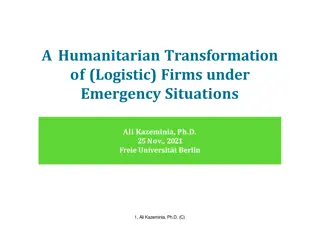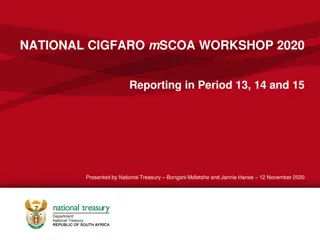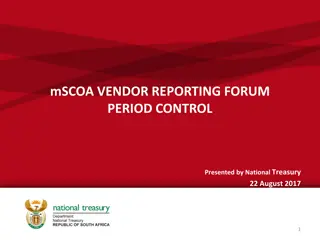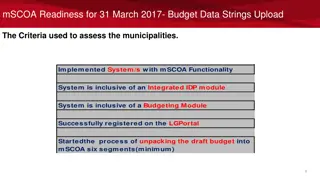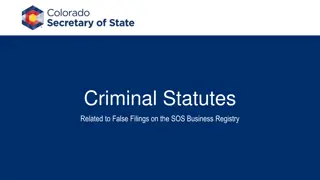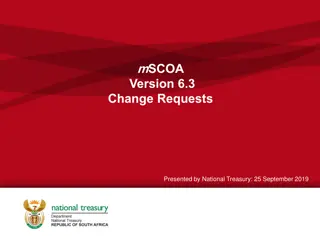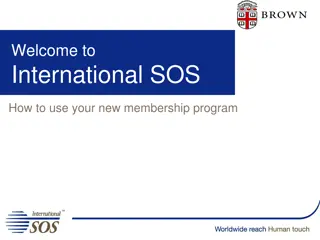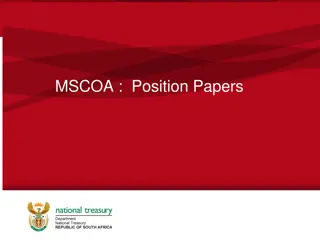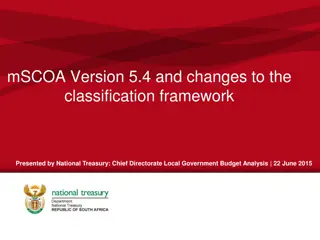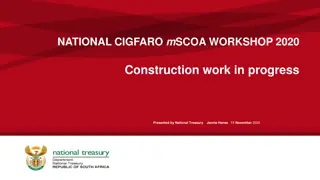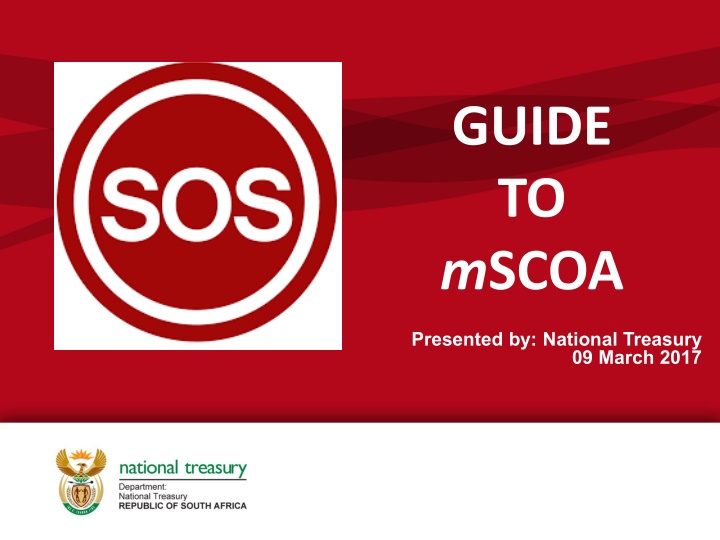
mSCOA Project Segment Guide for Municipalities
This guide provides insight into the mSCOA project segment, outlining its purpose in accumulating project-related transactions and linking operational and capital expenditures to projects. It emphasizes the alignment of projects with budgets and the breakdown required for capturing transactions effectively. Municipalities are required to define the level for transaction capture and adopt the parent-child code structure as per National Treasury guidelines. Detailed descriptions and segmented application processes are discussed to enhance project management and financial reporting.
Download Presentation

Please find below an Image/Link to download the presentation.
The content on the website is provided AS IS for your information and personal use only. It may not be sold, licensed, or shared on other websites without obtaining consent from the author. If you encounter any issues during the download, it is possible that the publisher has removed the file from their server.
You are allowed to download the files provided on this website for personal or commercial use, subject to the condition that they are used lawfully. All files are the property of their respective owners.
The content on the website is provided AS IS for your information and personal use only. It may not be sold, licensed, or shared on other websites without obtaining consent from the author.
E N D
Presentation Transcript
GUIDE TO mSCOA Presented by: National Treasury 09 March 2017
mSCOA PROJECT SEGMENT
mSCOA PROJECT SEGMENT Purpose The review of information received from selected municipalities highlighted the need for a segment containing the information on the various projects. The detailed accounts included various accounts for project-related expenditure combined in a single line-item being the only way, in the existing account structure, to accumulate financial information on important or strategic projects. 3 3
mSCOA PROJECT SEGMENT Purpose The accumulation of project-related transactions in a single posting-level account results in a classification not relating to what is bought . This segment is structured to link all operational and capital expenditure to a project whether it is a specific capital project, operational initiative or running the municipality. The Project segment distinguishes projects according to the nature of the expense whether it is a capital or an operational expense. 4 4
mSCOA PROJECT SEGMENT Purpose This segment is to ensure that all projects in the IDP are aligned to budgets. 5 5
mSCOA PROJECT SEGMENT Application Project Capital Operational Default Lets look at some of the elements of Capital and Operational projects in detail 6 6
mSCOA PROJECT SEGMENT Application The municipalities are required to define the level for capturing the transaction, expand the parent-child code structure and adopt the guide of the parent. . National Treasury is not interested in further detail but the municipality may add detail at own discretion. This will not be extracted for reporting to National Treasury. Breakdown Required 7 7
mSCOA PROJECT SEGMENT Application The project segment requires you to allocate a posting level specific to the municipality s project. The project segment should include the parent GUID (which is the GUID attached to the lowest level description on the mSCOA project chart indicating that breakdown is required) and a five digit incremental project- number separated by the underscore symbol. 8 8
mSCOA PROJECT SEGMENT Application The five digit incremental project- number is unique to the municipality. Example: Unique incremental project number 9a233b1b-5c0f-4843-a8fc-1732a64c5d42_00001 9a233b1b-5c0f-4843-a8fc-1732a64c5d42_00002 Parent GUID per mSCOA Chart 9 9
mSCOA PROJECT SEGMENT Application Failure to budget on posting levels will result in the municipalities file being rejected and will result in non-compliance. 10 10
mSCOA PROJECT SEGMENT Application Capital: Infrastructure Projects are classified in this category if complying with the definition of an Infrastructure Asset . Some assets are commonly described as infrastructure assets while there is no universally accepted definition of infrastructure assets, these assets usually display some or all of the following characteristics: 11 11
mSCOA PROJECT SEGMENT Application Capital: Infrastructure Projects are classified in this category if complying with the definition of an they are part of a system or network; Infrastructure Asset . they are specific in nature and do not have alternative uses; Some assets are commonly described as infrastructure assets while they are immovable; and there is no universally accepted definition of infrastructure assets, these they may be subject to constraints at assets usually display some or all of the following characteristics: disposal. 12 12
mSCOA PROJECT SEGMENT Application Capital: Infrastructure Definition from the CIDMS: Infrastructure Assets Stationary systems forming a network and serving whole communities, where the system as a whole is intended to be maintained indefinitely at a particular level of service potential by the continuing replacement and refurbishment of its components. 13 13
mSCOA PROJECT SEGMENT Application Capital Projects: Renewal vs Upgrading Renewal: Expenditure on an existing Upgrading: The asset that returns the service potential of replacement of an asset or the asset or expected useful life of the addition/replacement of an asset to that which it had originally. asset component, which materially improves the original service potential **Rehabilitation and Refurbishment used in earlier versions up to V5.4 and then replaced with Renewal to align to the CIDMS. of the asset. 14 14
mSCOA PROJECT SEGMENT Application Depreciation In achieving the requirements in SA34D relating to depreciation, National Treasury requests that all municipalities follow the same structure in dealing with depreciation items. Municipalities MUST transact for depreciation per asset class. 15 15
mSCOA PROJECT SEGMENT Application Depreciation (cont.) The business rule that informs this treatment of depreciation requires for municipalities to create sub projects below Municipal Running Costs in the project segment. These sub projects will carry the same GUID structure as for projects that indicate breakdown required , i.e. parent GUID and a sequential 5 digit unique project number. 16 16
mSCOA PROJECT SEGMENT Application Depreciation(cont): These unique project numbers have been pre-set as follows (as per Appendix E of mSCOA Circular No.7): 17 17
mSCOA PROJECT SEGMENT Application Depreciation (cont): Example Depreciation for other assets stores will be accounted for on the following GUID accommodated in Municipal Running Costs in the project segment: Unique incremental project number 53d432c7-5d06-4d53-a785-f29995840060_99903 Parent GUID per mSCOA Chart: Municipal Running Costs 18 18
mSCOA PROJECT SEGMENT Application Assets The mSCOA classification aligns with and enforces the CIDMS framework. This creates an enabling environment for standardised asset classifications. This means that a municipality must review its asset classifications on its existing asset register to update and align it with mSCOA (which incorporates CIDMS). 19 19
mSCOA PROJECT SEGMENT Application Assets (cont.) This is imperative as new acquisitions will be classified as per the mSCOA Item (asset) chart. Furthermore, in view of mSCOA requiring full integration of the asset management sub-system(s), the municipality needs to ensure that the asset register also contains full information on each asset (aligning with mSCOA) to enable credible reporting and ease in decision making. 20 20
mSCOA PROJECT SEGMENT Application Cities Infrastructure Delivery and Management System (CIDMS) The CIDMS is an initiative of the Cities Support Programme (CSP) of National Treasury. It aims to deliver guidelines and an implementation strategy designed to assist cities to sustainably and visibly increase their spending on infrastructure delivery in support of enhanced cities functioning and efficiencies, and therefore accelerated economic growth, as well as social upliftment and cohesion through the production of serviced land, housing and complimentary municipal public amenities. 21 21
mSCOA PROJECT SEGMENT Application Cities Infrastructure Delivery and Management System (CIDMS) The guidelines are prepared to document a system that, when implemented, will establish a framework for robust management of infrastructure across lifecycles and asset portfolios. 22 22
mSCOA PROJECT SEGMENT Application Assets (cont.): Opening Balances The initial take on of assets and balance sheet budgeting will require municipalities to use the Capital allocation in the project segment as this is in line with the CIDMS. Take on balances for Construction Work in Progress must also be allocated to the relevant project. New projects for both Infrastructure and Non- Infrastructure in combination with the opening balance in the item segment will construe a take on balance . 23 23
mSCOA PROJECT SEGMENT Application Assets (cont.): Opening Balances Opening balances are currently non-posting levels for assets in the item asset chart. As a functionality rule, the opening balance will be a posting level and can also be used for take on balances, adjustments and automated movement of the previous months closing balance. 24 24
mSCOA PROJECT SEGMENT Application Assets (cont.): Opening Balances The closing balance will be calculated automatically by the municipality s financial management system and will remain a non-posting level. It is a requirement to transact on the movement accounts which are posting levels. 25 25
mSCOA PROJECT SEGMENT Application Assets (cont.): Opening Balances Municipalities and their entities are required to allocate take on balances to the Item and Function segment at a minimum, however prudence should be applied to the other segments and allocated according to the historic information available. The allocation is thus not default project as would be the case for all other balance sheet items when budgeting for the opening balances. 26 26
mSCOA PROJECT SEGMENT Application Assets (cont.): Opening Balances This will only be necessary to align the initial take on balance, however, once the municipality is transacting, assets will be aligned to all mSCOA segments and any initial misstated allocations will correct themselves. The initial allocations should be made as accurately as possible across all 6 segments ( Municipal Standard Classification segment being optional). 27 27
mSCOA PROJECT SEGMENT Application Assets (cont.): Opening Balances Example 28 28
mSCOA PROJECT SEGMENT Application Assets (cont.): Opening Balances Example Opening balances will be considered posting levels Closing balances are non-posting levels 29 29
mSCOA PROJECT SEGMENT COST OF FREE BASIC SERVICES
mSCOA Treatment of Free Basic Services Application Consistently with Standards of GRAP 9 and GRAP 23 read with IGRAP 1, municipalities should not gross up revenue to reflect the Cost of Free Basic Services covered by the equitable share, or Revenue Foregone in the annual financial statements. . 34 34
mSCOA Treatment of Free Basic Services Application Currently according to national policy, free basic services includes 6kl of water, 50kWh electricity, free sewerage and free weekly refuse removal for households earning less than the prescribed amount. Amounts provided to the indigent consumers must be recorded at cost through the billing system. Contra the cost of the free basic services: Credit the debtors account and debit the relevant mSCOA revenue component of the chart. 35 35
mSCOA Treatment of Free Basic Services Example: Indigent Debtor incurs a bill of R1000.00 for electricity usage at tariff. The indigent receives relief of R200.00 which is the cost of free basic services (50 KWh). The net effect is a revenue at tariff of R800. DEBIT CREDIT AMOUNT DESCRIPTION Trade and other Receivables: Electricity Revenue: Services Charges: Electricity 800.00 Collectable revenue Trade and other Receivables: Electricity Revenue: Services Charges: Electricity Revenue: Services Charges: Electricity Trade and other Receivables: Electricity 200.00 Subsidised Discount 200.00 Reducing the debtor s payable debt by the cost of free basic services 36 36
mSCOA Treatment of Free Basic Services DEBIT CREDIT AMOUNT Fund Project Trade and other Receivables: Electricity Revenue: Services Charges: Electricity 800.00 General Revenue: Service Charges: Electricity Default Trade and other Receivables: Electricity Revenue: Services Charges: Electricity 200.00 General Revenue: Equitable Share Default Revenue: Services Charges: Electricity Trade and other Receivables: Electricity 200.00 General Revenue: Equitable Share Cost of Free Basic Services: Electricity 37 37
mSCOA Treatment of Free Basic Services All cost of free basic services and revenue foregone items are accommodated in the project segment. These projects will be linked to the schedules. Cost of Free Basic Services Electricity (50 kw h per household per month) Waste Water Management (free minimum level service) Waste Management (removed once a w eek) Water (6 kl per household per month) Revenue Cost of Free Services Electricity (Other Energy) Housing (Top Structures) Rental Rebates Waste Management Waste Water Management Water Property Rates Rebate Bona Fide Farmers Rebate or Exemption Indigent Ow ners Pensioners/Social Grants Temporary Relief Rebate Phase-in Reductions/Discounts General Residential Rebate (excess exceeding R15000 Threshold Rebate) Discretionary Disaster or Adverse Conditions 38 38
Linking Cost of Free Basic Services to SA1, SA9, SA10 which Feeds to A1 Schedules Extract of SA1 Service charges - electricity revenue Total Service charges - electricity revenue less Revenue Foregone (in excess of 50 kwh per indigent household per month) less Cost of Free Basis Services (50 kwh per indigent household per month) Net Service charges - electricity revenue Project: Cost of Free Basic Services: Electricity 39 39
mSCOA Treatment of Subsidised Basic Services Example: Debtor incurs a bill of R1000.00 for electricity usage at revenue cost and is further given R200.00 discretionary discount. This discount is at the same tariff as the revenue cost. DEBIT CREDIT AMOUNT DESCRIPTION Trade and other Receivables: Electricity Trade and other Receivables: Electricity Revenue: Services Charges: Electricity 800.00 Collectable revenue Revenue: Services Charges: Electricity 200.00 Subsidised Discount Revenue: Services Charges: Electricity Trade and other Receivables: Electricity 200.00 Reducing the debtor s payable debt by the subsidised discount 41 41
mSCOA Treatment of Subsidised Basic Services DEBIT CREDIT AMOUNT Fund Project Trade and other Receivables: Electricity Revenue: Services Charges: Electricity 800.00 General Revenue: Service Charges: Electricity Default Trade and other Receivables: Electricity Revenue: Services Charges: Electricity 200.00 General Revenue: Service Charges: Electricity Default Revenue: Services Charges: Electricity Trade and other Receivables: Electricity 200.00 General Revenue: Service Charges: Electricity Revenue Cost of Free Basic Services: Electricity 42 42
Linking Cost of Subsidised Basic Services to SA1, SA9, SA10 which Feeds to A1 Schedules Extract of SA1 Service charges - electricity revenue Total Service charges - electricity revenue less Revenue Foregone (in excess of 50 kwh per indigent household per month) less Cost of Free Basis Services (50 kwh per indigent household per month) Net Service charges - electricity revenue Project: Revenue Cost of Free Basic Services: Electricity 43 43
mSCOA Treatment of Property Rates Rebates Example: A Pensioner incurs a total bill of R1000.00 for property rates of which, R200.00 is the rebate. DEBIT CREDIT AMOUNT DESCRIPTION Receivables- Non Exchange: Property Rates Revenue: Property Rates: Residential 800.00 Collectable revenue Receivables- Non Exchange: Property Rates Revenue: Property Rates: Residential 200.00 Property Rates Rebate Revenue: Property Rates: Residential Receivables- Non Exchange: Property Rates 200.00 Reducing the debtor s payable debt by the property rates rebate 45 45
mSCOA Treatment of Property Rates Rebates DEBIT CREDIT AMOUNT Fund Project Receivables- Non Exchange: Property Rates Revenue: Property Rates: Residential 800.00 General Revenue: Taxes: Property Rates Default Receivables- Non Exchange: Property Rates Revenue: Property Rates: Residential 200.00 General Revenue: Taxes: Property Rates Default Revenue: Property Rates: Residential Receivables- Non Exchange: Property Rates 200.00 General Revenue: Taxes: Property Rates Property Rates Rebates: Pensioners 46 46
Linking Property Rates Rebates to SA1, SA9, SA10 which Feeds to A1 Schedules Extract of SA1 REVENUE ITEMS: Property rates Total Property Rates less Revenue Foregone (exemptions, reductions and rebates and impermissible values in excess of section 17 of MPRA) Net Property Rates Project: Property Rates Rebates: Pensioners 47 47
mSCOA FUNCTION SEGMENT
mSCOA FUNCTION SEGMENT Purpose The Function segment is the location within mSCOA for creating a standardised vote structure throughout municipalities. In addition, the segment makes distinction between core- and non-core functions or also known as funded- or unfunded mandates and agency services. 49 49
mSCOA FUNCTION SEGMENT Purpose The South African Cities Network defines an unfunded / underfunded mandate as: when municipalities perform the functions of other spheres of government and bear significant cost out of their own revenue sources . These unfunded / underfunded mandates pose an institutional and financial risk to the municipality as substantial amounts of own funding is being allocated to non-core functions at the expense of basic service delivery which is the core mandate of the municipality. 50 50




